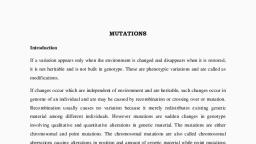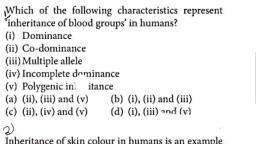Page 1 : Topic – Aneuploidy, Sub: Botany, Course- M. Sc.(semester IV) , Department of Botany, Paper- MBOTEC-1 Cytogenetics and Crop improvement, Unit- I, , Rajlaxmi Singh, Assistant Professor, P. G. Department of Botany,, Patna University,, Patna-800005, Email id:
[email protected]
Page 2 :
Aneuploidy, Variations in chromosome number may occur that do not involve whole sets of chromosomes, but, only parts of a set. The term aneuploidy is given to variations of this nature., Aneuploidy describes anumerical change in part of the genome, usually a change in the dosage, of a single chromosome. Individuals that have an extra chromosome, are missing a chromosome, or, have a combination of these anomalies are aneuploid. This definition also includes pieces of, chromosomes. Thus ,an individual in which a chromosome arm has been deleted is also considered, to be aneuploid., A loss or gain of one or few chromosomes as compared to the somatic chromosome number of, a species is known as aneuploidy. The deviation is from a diploid set up (2n). The change in, chromosome number do not involve the whole genome; they involve only one or few chromosomes, of the genome., Aneuploidy means presence of a chromosome number which is different than an exact multiple, of a basic chromosome number. For instance if 7 is the basic chrosome number, where the somatic, chromosome number is 2n=14, then chrosome numbers like 2n=15 or 2n=13 would be aneuploids., Thus aneuploidy can be either due to gain of one or more chromosomes or due to loss of one or, more chromosomes from a complete somatic or diploid chromosome complement., , Classification of Aneuploids, A. Hyperploidy- Aneuploidy which is due to gain of one or more chromosomes from a complete, somatic or diploid chromosome complement., 1. Trisomy(2n+1) - Diploids that have one extra chrosome are represented by the chromosomal, formula 2n+1. Trisomic individuals possess one extra chrosome than 2n. Trisomics are, grouped into the following categories depending on the constitution of the additional, chromosome., , •, •, , •, , Primary trisomic- The additional chrosome is an unaltered member of the haploid, chromosome complement of the species. Therefore, there can be n different primary, trisomics of a species. e.g. 7 in barley 10 in maize,12 in Datura etc., Secondary trisomic- The extra chromosome present is an isochrosome(a metacentric, chromosome in which the two arms are identical; produced through a transeverse division of, the centromere of a chromosome. Therefore, 2n different types of secondary trisomics are, possible in a species. e.g. 1.2 would produce 1.1 and 2.2 secondary trisomics., Tertiary trisomic- Trisomics where the extra chromosome present is a segment from nonhomologous chromosome. It has a translocated chromosome in addition to the normal, somatic complement. A large number of different types of tertiary trisomics are possible in a, species, e.g. chromosome 1.2 and 3.4 may give rise to the following tertiary trisomics 1.3,, 1.4, 2.3, 2.4, 3.1, 3.2, 4.1 and 4.2.
Page 3 :
2. Tetrasomy(2n+2) - When one chromosome of an otherwise diploid organism is present, in quadruplicate, this is expressed as 2n+2. Tetrasomic individuals have one additional, chromosome pair. Complete one homologous pair is added., , 3., , B.Hypoploidy- Aneuploidy which is due to loss of one or more chromosomes from a complete, somatic or diploid chromosome complement., 1. Monosomy(2n-1) - Diploid organisms that are missing one chromosome of a single pair are, monosomics with the genomic gormula 2n-1. There is deficit of a chromosome from the, somatic number of a species. Thus, in this any one chromosome is missing from a, homologous pair., , 2. Nullisomy(2n-2) – An organism that has lost a chromosome pair is a nullisomic. In this
Page 4 :
complete one homologous pair is lost. The result is usually lethal to diploids., , Origin and Production of Aneuploids, •, , Due to abnormal distribution of chromosomes during anaphase of meiosis, because of, irregular chromosome distribution at the poles one daughter cell receives one or more extra, chromosome and the counterpart lacks one or more chromosomes. This type of abnormal, situation arises when one or more pair of chromosomes(bivalents) fail to separate or disjoin, and move to one pole as such. This is called disjunction. So gametes having extra, chromosome when fuse with normal haploid gametes results in hyperploidy and those, containing one or more chromosomes less than a haploid no. if unite with normal haploid, gamete produces hypoploidy., • Loss of individual chromosome in meiosis leading to the formation of nuclei with hypoploid, chromosome number., • Irregularities in the segregation of chromosomes during meiosis in polyploids causes, development of aneuploids., Trisomy- Although trisomics may occur spontaneously in nature, they are rare., , Tetrasomy- In diploids tetrasomics are rarely obtained, but in polyploids these can be obtained by
Page 5 :
selfing progenies of trisomics., Monosomy- Spontaneous production of monosomics have been reported in wheat, tobacco, cotton, and oats. Irradiation treatment of the inflorescence leading to non-disjunction of of a normal, bivalent produces monosomics in cotton. In wheat a haploid as female when crossed to normal, hexaploid male produced monosomics., Nullisomy- Selfing of monosomics give rise to nullisomics., , Cytological behaviour of Aneuploids, Trisomy- One of the pairs of the chromosomes has an extra member, so that a trivalent striuture, may be formed during meiotic metaphase. If two chromosomes of the trivalent go to one pole and, the third goes to the opposite pole, then gametes will be (n+1) and (n)., In primary and secondary trisomics, the three homologues of the concerned chromosome may, pair with each other to form a trivalent of different configurations at metaphase1, or two of the, chromosomes may form a bivalent leaving the additional chromosome as a univalent., In a tertiary trisomic a dumb-bell shaped figure containing five chromosomes at metaphase1 is, seen. Thus secondary and tertiary trisomics may be distinguished from primary trisomics due to the, presence of a ring of three chromosomes and a dumb-bell shaped figure of five chromosomes, respectively., Tetrasomy – A quadrivalent may form for this particular chromosome during meiosis. Meiotic, chromosome pairing usually produces quadrivalents (four synapsing chromosomes) that can
Page 6 :
produce genetically balanced gametes if disjunction is by twos, that is, two chromosomes of the, quadrivalent going to one pole and the other two to the opposite poie. If disjunction is not stabilised, in this fashion for all quadrivalents, the gametes will be genetically unbalanced. Sterility will be, expressed in proprotion to the production of unbalanced gametes., Monosomy- The single chromosome without a pairing partner may go to either pole during, meiosis, but more frequently will lag at anaphase and fails to be included in either nucleus., Monosomics can thus form two kind of gametes, (n) and (n-1). In plants, the n-1 gametes seldom, function. In animals, loss of one whole chromosome often results in genetic unbalance, which is, manifested by high mortality or reduced fertility., Since in a monosomic one chromosome of the haploid complement doesnot have a pair, it remains, unpaired during meiosis and is present as a univalent at metaphase1. During anaphase1, the, bivalents disjoin normally, while the single univalent may follow any one of the following courses:, • move to one of the two poles., • Lag behind at the metaphase plate and be ultimately lost., • Divide into two chromatids which move to the opposite poles., Nullisomy- Chromosome pairing and the disjoining of bivalents to produce gametes is normal. But, in c ertain nullisomics regular chromosome pairing is disturbed and multivalent associations are, present at metaphase1., , Uses of Aneuploids, 1. They have been used to determine phenotypic effects of loss or gain of different, chromosomes., 2. Aneuploids have been used to produce chromosome substitution lines which yield, information on the effects of different chromosomes of a variety on various plant, characteristics, when they are placed singly in the same genetic background., 3. Aneuploid analysis permitts the location of a gene as well as linkage of a group, onto, a specific chromosome., 4. Aneuploids are useful in the identification of the chromosomes involved in, translocations., • Use of trisomics in chromosome mapping- trisomics can be utilized for locating, genes on specific chromosomes and for finding out distances of these genes from, centromere, a technique called chromosome mapping. If linkage groups are already, established in an organism, trisomics can be effectively used for assigning these, linkgage groups to specific chromosomes., • Tetrasomics are used to produce compensating nullisomic tetrasomic lines siggesting, homeologous relationships., • Monosomic analysis is used for locating genes on chromosomes in polyploid crops., • Use of nullisomics in locating genes on chromosomes- The genes which are, dominant can often be located by observing the absence of the trait in the, nullisomics. For instance, Chinese Spring wheat has red seed, but nulli-3D has white, seeds suggesting that the gene for red grain is located on 3D.
Page 7 :
References, 1. Elrod, Susan and Stansfield, William (2002). Genetics, Tata McGraw-Hill Publishing, Company Limited, New Delhi., 2. Gupta, P. K. (2004). Cytogenetics, Rastogi Publications,Meerut., 3. Simmons, M. J. and Snusted, D. Peter.Principles of Genetics, John Wiley and Sons, Inc., 4. Strickberger, M. W. Genetics, Prentice Hall of India, New Delhi.













































